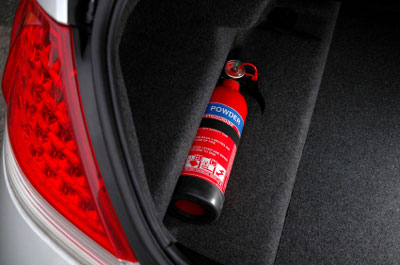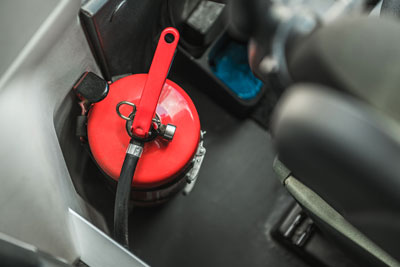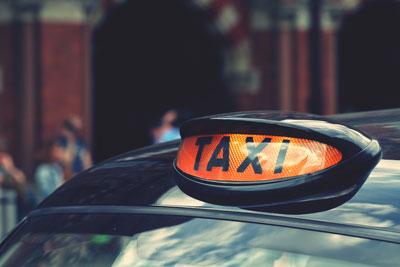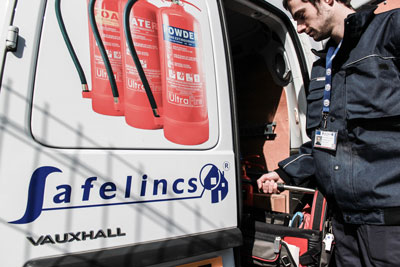-
Contact
Sales & Customer Service
0800 612 6537 support@safelincs.co.uk Live ChatDelivery Enquiries
0800 077 6149 - Resources
Fire & Safety Solutions
CALL OUR TEAM NOW 0800 612 6537
Also FREE from UK mobiles
Free Delivery
on 100s of Products
Live Chat - Online
Instant help & Advice
Trade Discounts
and exclusive pricing
0% Credit Available
Open an account now
5 Star Customer Feedback
Fire Extinguishers for Vehicles
This guide will help you decide the best fire extinguisher for your vehicle. Fire extinguishers, whilst not a legal requirement for private cars in the UK, are required in commercial and public vehicles as well as HGVs. If you are a private motorist, you may still want to consider having an extinguisher in your car for added peace of mind. Having one close at hand if a fire breaks out will mean you can put it out quickly before it gets out of hand, limiting damage.
Powder extinguishers or foam extinguishers are usually recommended as the best fire extinguishers for petrol or diesel vehicles because of their ability to extinguish class B (flammable liquid) fires. Our advice is based on guidelines for the UK and you should always check the requirements of any other country you are travelling to. In some other countries such as Poland, carrying a fire extinguisher in the car is a legal requirement.
Cars

ABC dry powder extinguishers are usually recommended as the best car fire extinguisher. A 1kg or 2kg unit is usually sufficient. All extinguishers should be securely fixed inside the car with a bracket so that it cannot get damaged during travel.
Powder extinguishers suitable for use on car fires can be stored in the vehicle overnight and throughout the year as we do not experience temperatures below -40° and above 50° in the UK. It is however recommended to store your extinguisher out of direct sunlight in the boot of the car. Storing your extinguisher in the boot will also force you to get out of the car to operate it (which is safer) and it is less likely to get damaged in an accident.
An employer may need to install a fire extinguisher in a company car. Whilst there is no law that says it is a requirement, every company has a duty to keep its employees safe. A company car is considered to be a ‘workplace’ and so a risk assessment may decide that it is necessary depending on how and where the vehicle is used.
Public transport (PSV)

AFFF Foam extinguishers are largely recommended for use on public transport vehicles. All of our foam fire extinguishers meet the minimum standards of class A (5A or 8A is recommended) and class B fires and are manufactured to comply with the EN3 standards with CE and BSI Kitemark.
Some vehicles such as buses, coaches or minibuses are legally required to carry at least one 2L portable fire extinguisher. This requirement may be more on a wheelchair accessible vehicle. The number of extinguishers required is not dependent on the size of the vehicle or it’s seating capacity.
Fire extinguishers should always be secured with a bracket suitable for transport to prevent damage in transit.
Public transport vehicles may also have additional regulations set out by their local authority.
Commercial vehicles including vans

ABC dry powder extinguishers are recommended as the best fire extinguishers for vans and other small commercial vehicles. A 2kg extinguisher of this type stored securely in the cab is sufficient for most commercial vehicles that are not carrying dangerous goods.
If the vehicle is used in the carriage of dangerous goods (CDG) the minimum amount of dry powder is specified depending on the permissible mass of the vehicle. For example, a vehicle carrying up to 3.5 tonnes should have a 2kg dry powder extinguisher in the cab and another 2kg dry powder extinguisher stored securely elsewhere.
Always use a transport bracket to fix the extinguisher securely.
HGVs

ABC dry powder extinguishers are recommended for use in lorries or trucks. Heavy goods vehicles that are not carrying dangerous goods should be equipped with at least one portable fire extinguisher that is suitable for tackling class A (solid combustibles such as wood), B (flammable liquid) and C (flammable gas) fires. The extinguisher should have a minimum capacity of 2kg of dry powder.
Store extinguishers in the cab using a secure transport bracket.
HGVs carrying dangerous goods have to comply with the CDG and ADR regulations where the minimum amount of dry powder is specified depending on the vehicle tonnage. For example, for an HGV between 3.5 tonnes and 7.5 tonnes, a 2kg powder extinguisher is required in the cab with a further 6kg stored elsewhere on the vehicle (total 8kg). For other vehicle tonnage, check the minimum dry powder provision.
Larger extinguishers such as 6kg or 9kg can be secured to the exterior of the vehicle using a vehicle box.
Taxis or PHVs (Private hire vehicles)

Taxis and private hire vehicles are required by law to carry a fire extinguisher and a first aid kit. The local vehicle licensing authority will set out the type and capacity of the extinguisher (in accordance with Local Government (Miscellaneous Provisions) Act 1976).
For PHVs (a vehicle capable of carrying 9 or more passengers) a 2L AFFF foam extinguisher is required, although it is advisable to check with your local authority for any further requirements.
Caravans or motorhomes

Water Mist extinguishers are the best extinguishers for caravans or motorhomes due to their ability to extinguish class A, B and C fires plus they are safe for use on electrical equipment. The 1L Water Mist Extinguisher is compact and leaves absolutely no residue to clean up after use.
ABC dry powder extinguishers have traditionally been used in caravans, however they are generally not recommended for use in a confined space as there is a danger of inhalation of the powder and visibility could be impaired.
Fire extinguisher maintenance

If you are unsure about the requirements and your responsibilities for fire safety in a business or organisation, we advise that a suitable fire risk assessment is carried out by a competent person.
Most fire extinguishers require regular visual inspections and annual servicing. Any vehicle carrying hazardous goods should display a label on each extinguisher showing the next service date.
Alternatively, P50 service-free fire extinguishers may be a consideration. These could save you money as they do not require annual servicing and have a 20 year life span.
Although most fire extinguishers don’t have an expiry date, they typically last around 10 years, after which they should be replaced. Most of our fire extinguishers come with a minimum warranty of 5 years for added peace of mind.
Larger extinguishers should have a manufacturing date imprinted on the outer casing and may need to be refilled or refurbished after a specific period of time.
Reviewed: 28/02/2023 (doc:548 V1.0). Our articles are reviewed regularly. However, any changes made to standards or legislation following the review date will not have been considered. Please note that we provide abridged, easy-to-understand guidance. To make detailed decisions about your fire safety provisions, you might require further advice or need to consult the full standards and legislation.



















